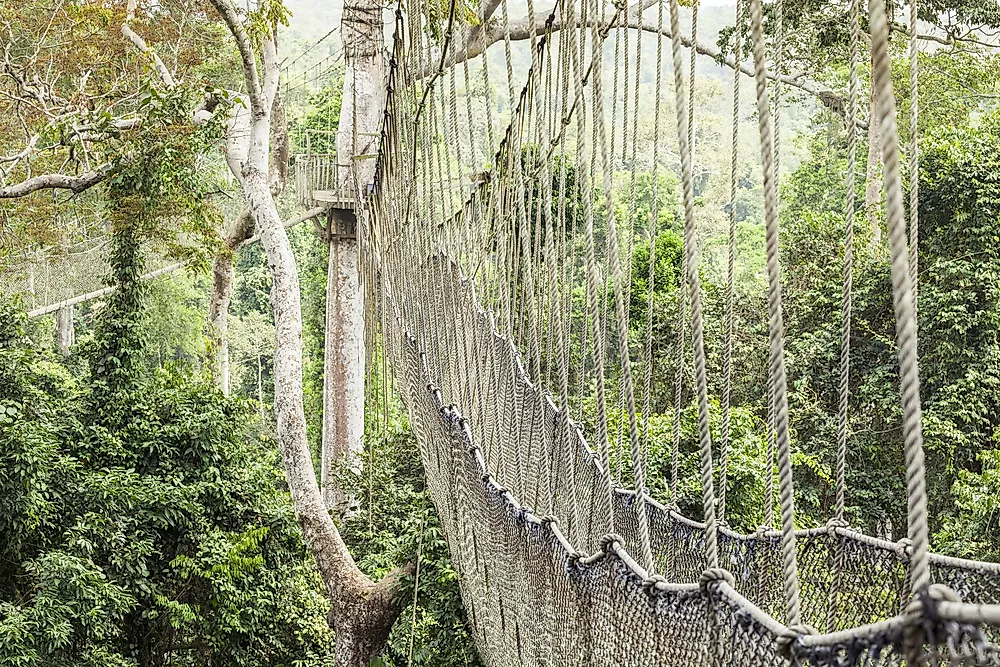The Seven National Parks Of Ghana

Ghana is an African nation located in West Africa. The country has 21 protected areas including 7 national parks. The national parks of Ghana are listed below.
7. Bia National Park
The Bia National Park and biosphere reserve is located in Ghana’s Western Region. The park encompasses an area of 563 square km and protects one of the last remaining pristine forests of the country. Some of West Africa’s highest trees are found here. The Bia National Park was established in 1935 and is named after the river Bia flowing close by. 62 mammalian species including 10 species of primates, more than 160 species of avians, and other wildlife including many threatened species inhabit this national park.
6. Bui National Park
This national park of Ghana was founded in 1971 with the aim to protect the flora and fauna of the region. The park has an area of 1820 square km. The Bui National Park is well known for its large population of hippopotamuses in the Black Volta. The protected area is also home to numerous species of birds and a great variety of antelopes. The white and black colobus monkey, an endangered species, also lives in the Bui National Park. The construction of the Bui Dam currently threatens the habitat of the park and is expected to inundate a part of the park.
5. Digya National Park
Encompassing an area of 3,743 square km, Digya National Park is Ghana’s second largest national park. It is located in the Brong-Ahafo Region of the country. It was established in 1900 as the country’s first protected area and designated as a national park in 1971. The Lake Volta lies at the borders of the Digya National Park. The park has an undulating terrain in the transitional area between savanna and forests. The park’s notable wildlife include six species primates, African elephants, manatees, clawless otters, and more. 236 species of birds call this park their home.
4. Kakum National Park
Spanning an area of 375 square km, this national park is located in Ghana’s Central Region. The protected area was established in 1931 and upgraded to the status of a national park in 1992. The national park is unique in that it was established by the initiatives taken by local people instead of the government of the country. The tropical rainforest habitat of the park can be easily observed by means of the canopy walkway built here. The Kakum National Park houses several endangered species like the African elephant, Diana monkey, bongo antelope, and others. The park has also been declared as an Important Bird Area due to its rich avifauna. 266 species of birds are found in this park.
3. Kyabobo National Park
Kyabobo National Park spans an area of 360 square km. It is located on Ghana’s border with Togo in the Volta Region of the country. The Kyabobo National Park was founded in 1997. It hosts the country’s second tallest peak, Mount Dzebobo. African bush elephants, duikers, waterbuck, African buffalo, etc., are some of the notable wildlife of this area. 235 species of birds and 500 species of butterflies also inhabit the Kyabobo National Park.
2. Mole National Park -
This national park is the largest one in Ghana. It occupies an area of 4840 square km. The park is located in the country’s northwest and features riparian and grassland ecosystems. The park was first established as a protected area in 1958 and later designated a national park in 1971. Over the years, it has been developed as a major tourist destination in the country. More than 93 species of mammals including elephants, warthogs, buffalos, hippos, etc., are found here. Several species of primates also live here. 344 species of birds like herons, egrets, martial eagle, shrikes, palm-nut vultures, etc., are also found in the Mole National Park.
1. Nini-Suhien National Park
A small national park, the Nini-Suhien National Park occupies an area of 160 square km in Ghana. The national park was established in 1976. It is part of the Ankasa Conservation Area.











